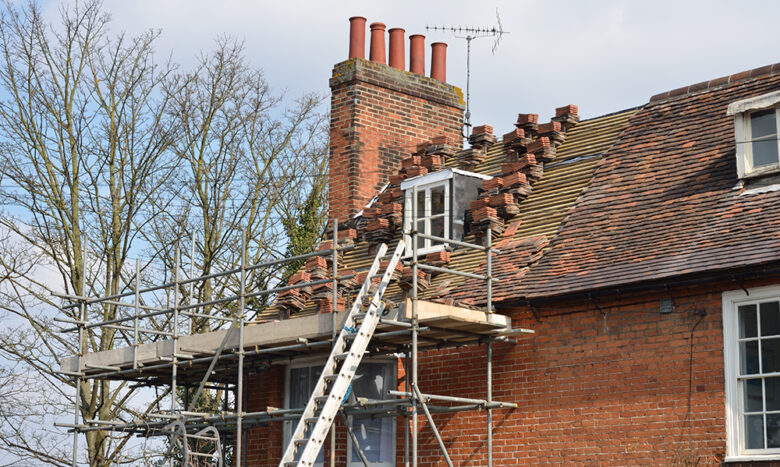
How Much Will It Cost to Replace My Roof?
There’s no denying that a solid and structurally sound roof is essential for every building. There’s also no denying that discovering you have to replace or significantly repair your roof can fill you with dread, especially as it’ll likely come with a hefty price tag. While completing the work is unavoidable, there are ways to make sure you don’t spend more than you need to and to ensure the problems are properly fixed.
How do I know when I need a new roof?
As you can’t easily access or see your roof, it can be difficult to spot if there are potential problems ahead. There are, however, a few warning signs you can watch out for both inside your house and externally.
Internal signs are perhaps easier to see, but it likely means the problem is already pretty serious. For example, if you notice any water damage on ceilings, it’s a sign that rain is getting in through the roof. An even bigger problem would be seeing light from the outside, as this suggests holes or cracks in the roof. Earlier signs to spot would be dark streaks or mould, indicating you have moisture coming in from the roof. Finally, if you spot any sagging, call in an expert straight away, as this likely indicates serious structural issues.
Next, take a look at the external roof, as this may give you a clearer idea of the problem you’re facing. Signs that you need to carry out repairs include damaged tiles, insecure guttering and a build-up of moss or algae, which can lead to rot. When looking at guttering, check that there are no roof tile fragments or shingle pieces gathering, as this can signify that your roof is deteriorating. More serious issues you may be able to spot include sitting water, particularly on a flat roof, which may be a sign you need to improve drainage, and a sagging roof, which again will need immediate checking by an expert.
Also, when you buy a new home, find out when the roof was last fixed or replaced as age is one of the biggest factors in roof deterioration.
While some of these problems can be repaired relatively easily by a roofer, if you experience persistent issues that are starting to add up in terms of cost and inconvenience, if the roof is clearly in serious need of repair, or if you’re still unsure of exactly what’s going on up there, now may be the time to arrange a roof survey to see if it’s time for a replacement.
How much will it cost?
The good news is that by keeping a regular eye on your roof, you’ll hopefully catch any issues early, and so they’ll be cheaper to fix. The bad news is that if your roof needs to be replaced, it will be expensive.
The actual costs will depend on a number of factors, such as the size and type of roof you have, the type of materials you use, your roof’s shape and style, and whether or not you require structural changes. Carrying out work on a bungalow will be cheaper than a traditional house as scaffolding costs will be reduced. Different companies will also likely charge different fees, so don’t accept the first quote you receive. Location will also have an impact, with the cost of labour and materials varying across the country.
Typically, however, you can expect to pay between £7,500 and £12,500 for a standard terraced property; a semi-detached with a hipped roof would likely be in the region of £10,000 – £15,000; while re-roofing a detached house with a hipped four-slope roof could set you back £15,000 – £20,000. Flat roofs vary greatly depending on the size and materials.
How long will it take?
Similarly, when it comes to how long a re-roofing project will take, there is no definitive answer. For a typical three-bedroom home with standard concrete tiles, expect to schedule in about a week for the work, although again, there are a number of factors that will affect this.
Firstly, the good old British weather may not fit into your plans – rain and snow can make the project take longer, while cold can affect how the asphalt shingles stick and seal.
Roofing materials and design will also have an impact. Complex designs will take longer than the traditional horizontal style, while asphalt shingles will be quicker than slate or concrete tiles.
Size, of course, will be a major factor, as will ease of accessibility and steepness of the roof, with steeper pitches potentially requiring additional safety equipment.
The level of damage will also need to be taken into consideration. If the damage goes beyond simply replacing the shingles and affects the roof deck or other elements of the building, the project will take longer to complete. Extra time should also be set aside if your house requires additional work such as replacing roof rafters, roofline boards and guttering.
How can I maintain my roof?
Given the cost and time involved in replacing a roof, it’s worth doing everything you can to make your new roof lasts as long as possible in as good a condition as possible. The key thing to do here is to inspect your roof on a regular basis, particularly following periods of bad weather. Even from street height, it may be possible to see any loose or missing roof tiles or shingles, blocked gutters, damaged drain elements or other signs of deterioration.
Also, make sure any overhanging trees are cut back to avoid branches damaging your roof and minimise leaves falling into your guttering. In fact, clogged guttering is a common cause of leaky roofs so clear out leaves or other debris on a regular basis to ensure rainwater can run off quickly.
Finally, if you do notice a problem or think your roof and its components don’t look quite right, call in a professional. Spotting the problem earlier will means it’s more likely to be fixable without the need for major work.
What is a roof survey, and how can it help?
If you think you may need to carry out work on your roof or want confirmation of its current state, a roof survey will tell you exactly what condition your roof is in and what needs to be done to fix it. While your roofing company will also be able to do this, with a roof survey, you know the information you’re getting is truly impartial as the surveyor is not in any way linked to a company that could carry out the work.
If you’re trying to claim on your insurance for the repairs, you may be required to obtain an impartial report before you can make a claim. Even if this isn’t a requirement, an independent survey that details the extent of the damage, repair costs and cause of the problem will make it much more difficult for the insurer to reject your claim.
Therefore, a roof survey can help you avoid making a poor investment decision, arm you with the information you need to not pay over the odds, and ensure you get the repair work you need to maintain your property’s structural integrity.
The Novello Approach
Our roof surveys are carried out by expert roofing specialist John Brook, who spent more than 10 years as a roofing contractor before training to become an independent roofing surveyor at Novello.
As part of a thorough investigation into the state of your roof, we will visually assess its condition. If your roof appears unsafe or has hard-to-access areas, we’ll use specialist pole cams to inspect it as well as all its components, such as chimneys and guttering.
We’ll then prepare a detailed report highlighting the condition of your roof and its components, the roof’s life expectancy and the approximate cost of replacing or repairing it.
Armed with this information, you’ll be in a better position to make a clear decision about the work to be carried out and know you’re not paying more than you should be for it.
To find out more about the services we offer and how a roof survey could help you, contact us today.

